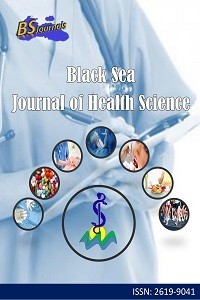Düşük Ayak Kliniği ile Başvuran Hastaların Etiyolojik, Elektrofizyolojik ve Prognostik Özellikleri
Düşük ayak, Etiyoloji, Peroneal nöropati, Elektromiyografi
Etiological, Electrophysiological and Prognostic Features of Patients Presenting with Drop Foot Clinic
Drop foot, Ethiology, Peroneal neuropathy, Electromyography,
___
- Altıntaş A, Gündüz A, Kantarcı F, Çelik GG. 2016. Sciatic neuropathy developed after injection during curettage. Agri, 28: 46-48.
- Aubuchon A, Arnold WD, Bracewell A, Hoyle JC. 2017. Sciatic neuropathy due to popliteal fossa nerve block. Muscle & Nerve, 56(4): 822-824.
- Cherian RP, Li Y. 2019. Clinical and electrodiagnostic features of nontraumatic sciatic neuropathy. Muscle & Nerve, 59(3): 309-314.
- Combarros O, Calleja J, Polo J, Berciano J. 1987. Prevalence of hereditary motor and sensory neuropathy in Cantabria. Acta Neur Scandinavica, 75(1): 9-12.
- Distad BJ, Weiss MD. 2013. Clinical and electrodiagnostic features of sciatic neuropathies. Physical Med Rehab Clin, 24(1): 107-120.
- Dyck P. 1993. Hereditary motor and sensory neuropathies. Perip Neuropathy, 1993: 1094-1136.
- Feinberg J, Sethi S. 2006. Sciatic neuropathy: case report and discussion of the literature on postoperative sciatic neuropathy and sciatic nerve tumors. HSS J, 2(2): 181.
- Ghate J, Ghugrare B, Patond K, Singh R. 2009. The electrophysiological profiles of the footdrop cases: a retrospective study. J MGIMS, 14(2): 36-39.
- Katirji MB, Wilbourn AJ. 1988. Common peroneal mononeuropathy: a clinical and electrophysiologic study of 116 lesions. Neurology, 38(11): 1723-1723.
- Kim JY, Do KKSHY. 2015. Isolated painless foot drop due to cerebral infarction mimicking lumbar radiculopathy: A case report. Korean J Spine, 12(3): 210.
- Kline DG, Kim D, Midha R, Harsh C, Tiel R. 1998. Management and results of sciatic nerve injuries: a 24-year experience. J Neurosurgery, 89(1): 13-23.
- Kurihara S, Adachi Y, Wada K, Awaki E, Harada H, Nakashima K. 2002. An epidemiological genetic study of Charcot-Marie-Tooth disease in Western Japan. Neuroepidem, 21(5): 246-250.
- Plewnia C, Wallace C, Zochodne D. 1999. Traumatic sciatic neuropathy: a novel cause, local experience, and a review of the literature. J Trauma and Acute Care Surg, 47(5): 986.
- Skre H. 1974. Genetic and clinical aspects of Charcot‐Marie‐Tooth's disease. Clinical Gen, 6(2): 98-118.
- Stewart JD. 2008. Foot drop: where, why and what to do? Practical Neurol, 8(3): 158-169.
- Toğrol E, Çolak A, Kutlay M, Saraçoğlu M, Akyatan N, Akin ON. 2000. Bilateral peroneal nerve palsy induced by prolonged squatting. Military Med, 165(3): 240-242.
- Topuz K, Kutlay M, Şimşek H, Atabey C, Demircan M, Şenol Güney M. 2011. Early surgical treatment protocol for sciatic nerve injury due to injection–a retrospective study. British J Neurosurg, 25(4): 509-515.
- Van Gompel JJ, Griessenauer CJ, Scheithauer BW, Amrami KK, Spinner RJ. 2010. Vascular malformations, rare causes of sciatic neuropathy: a case series. Neurosurg, 67(4): 1133-1142.
- Wiszniewski W, Szigeti K, Lupski J. 2013. Chapter 126–hereditary motor and sensory neuropathies. Emery and Rimoin’s principles and practice of medical genetics. 6th ed. Academic Press, Oxford, UK, 1-24.
- Yayın Aralığı: Yılda 4 Sayı
- Başlangıç: 2018
- Yayıncı: Cem TIRINK
A Classification Tree to Identify Factors Affecting Temporomandibular Disorders
Ayşe ÖZCAN KÜÇÜK, Utku Nezih YILMAZ, Bilal EGE, Mahmut KOPARAL, Eda Didem YALÇIN, Fatih ÜÇKARDEŞ
Kemal AKSOY, Abdulkerim DENİZ, Mert METİN
Evaluation of Dentists’ Knowledge in Infective Endocarditis Prophylaxis
Emine TATAR ŞATIROĞLU, Aliye KAMALAK
Efficacy of Virgin Olive Oil in Preventing Postoperative Peritoneal Adhesions
Fatih YURDADOĞAN, Hatice Sonay YALÇIN, İsmail SAYGIN, Haluk SARIHAN
Voiding Dysfunctions and Prevention after Prostate Biopsy. Prospective Observational Study
Aykut BAŞER, Mehmet Murat BAYKAM, Mustafa Serdar ÇAĞLAYAN, Cemil AYDIN, Muhammet YAYTOKGİL, Musa EKİCİ
Antiviral Tedavi Almadan Spontan İyileşen Astım ve COVID 19 Pnömolili Hastanın Üç Aylık Takibi
Işıl ALIRAVCI, Cemile ÇETİNKAYA, Sevil ALKAN ÇEVİKER
Ortodontide Stripping Uygulamalarına Genel Bakış
Metacognition and Ruminative Thinking as Predictors of Burnout: A Structural Equation Modelling
Sleep Hygiene and Happiness Levels of University Students Studying in Health-Related Departments
Hilal PEKMEZCİ PURUT, Burcu GENÇ KÖSE, Barış TÜRKER, Vacide AŞIK ÖZDEMİR, Bahar KEFELİ ÇOL
Kardiyovasküler Hastalıklar için Yeni Epigenetik Belirteçler: Dairesel RNA'lar
